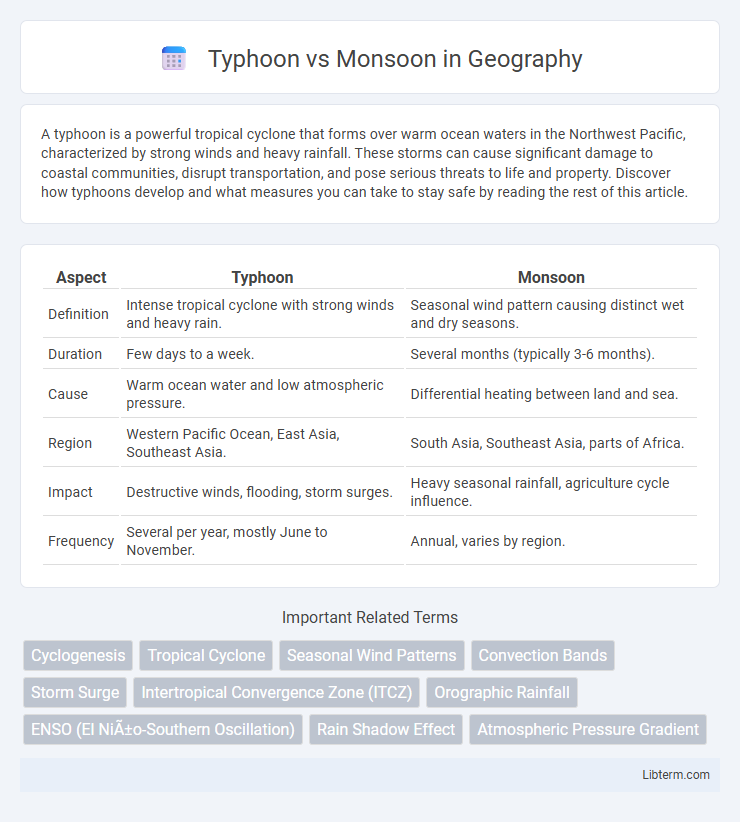A typhoon is a powerful tropical cyclone that forms over warm ocean waters in the Northwest Pacific, characterized by strong winds and heavy rainfall. These storms can cause significant damage to coastal communities, disrupt transportation, and pose serious threats to life and property. Discover how typhoons develop and what measures you can take to stay safe by reading the rest of this article.
Table of Comparison
| Aspect | Typhoon | Monsoon |
|---|---|---|
| Definition | Intense tropical cyclone with strong winds and heavy rain. | Seasonal wind pattern causing distinct wet and dry seasons. |
| Duration | Few days to a week. | Several months (typically 3-6 months). |
| Cause | Warm ocean water and low atmospheric pressure. | Differential heating between land and sea. |
| Region | Western Pacific Ocean, East Asia, Southeast Asia. | South Asia, Southeast Asia, parts of Africa. |
| Impact | Destructive winds, flooding, storm surges. | Heavy seasonal rainfall, agriculture cycle influence. |
| Frequency | Several per year, mostly June to November. | Annual, varies by region. |
Introduction to Typhoons and Monsoons
Typhoons are intense tropical cyclones that form over warm ocean waters in the Northwest Pacific, characterized by high winds and heavy rainfall. Monsoons refer to seasonal wind patterns that bring significant changes in precipitation, particularly in South Asia, resulting in distinct wet and dry seasons. Both phenomena play crucial roles in regional climate systems and significantly impact agriculture, water resources, and weather patterns.
Defining Typhoon: Key Characteristics
A typhoon is a powerful tropical cyclone forming in the Northwest Pacific Ocean, characterized by intense winds exceeding 74 mph and heavy rainfall that can cause severe flooding and storm surges. Unlike monsoons, which are seasonal wind patterns causing prolonged shifts in precipitation, typhoons are short-lived, rapidly developing weather systems with a well-defined eye and cyclonic circulation. Key characteristics include a low-pressure center, symmetrical cloud patterns, and the potential to disrupt coastal regions through high winds and storm-driven waves.
Understanding Monsoon: Essential Features
Monsoons are seasonal wind patterns characterized by a reversal in direction, bringing distinct wet and dry periods to regions such as South Asia and West Africa. These winds result from differential heating between land and ocean, causing heavy rainfall during the wet monsoon phase critical for agriculture. Unlike typhoons, which are intense tropical cyclones, monsoons influence long-term climate trends and precipitation distribution over large geographic areas.
Causes of Typhoons vs Monsoons
Typhoons form due to the rapid intensification of warm ocean waters above 26.5degC combined with low wind shear and atmospheric instability, primarily in the Northwest Pacific basin. Monsoons develop from the differential heating between landmasses and adjacent oceans, creating seasonal wind patterns that influence vast regions like South Asia and Southeast Asia. While typhoons rely on oceanic heat energy for cyclone formation, monsoons result from pressure gradients and temperature contrasts between continents and seas.
Geographic Locations Affected by Each
Typhoons primarily impact East Asia, including countries such as Japan, the Philippines, Taiwan, and China, often causing severe storms across the Western Pacific Ocean. Monsoons influence South Asia and Southeast Asia, with notable effects in India, Bangladesh, Sri Lanka, and parts of Indonesia, bringing seasonal heavy rains crucial for agriculture. Geographic regions affected by typhoons and monsoons each experience distinct weather patterns shaped by their location relative to ocean currents and atmospheric pressure systems.
Seasonal Patterns and Timing
Typhoons typically develop over warm ocean waters during late summer and early autumn, peaking between June and November in the Western Pacific. Monsoons follow a broader seasonal pattern, with the Southwest Monsoon occurring from June to September, bringing heavy rainfall to South and Southeast Asia, while the Northeast Monsoon prevails from October to March with cooler, drier air. Both phenomena are driven by atmospheric pressure changes but differ in timing and impact areas, with typhoons being intense tropical cyclones and monsoons representing large-scale wind patterns.
Impact on Weather and Climate
Typhoons generate intense rainfall, strong winds, and storm surges, causing sudden, severe weather disruptions primarily in coastal regions and leading to flooding, landslides, and infrastructure damage. Monsoons bring prolonged seasonal changes in wind patterns resulting in extended periods of heavy rainfall and drought, significantly influencing agricultural cycles and water resources in affected areas. Both phenomena alter regional climate patterns, but typhoons cause acute, short-term impacts, while monsoons drive long-term climate variability and ecosystem productivity.
Effects on Human Communities
Typhoons cause widespread destruction in human communities through intense winds, heavy rainfall, flooding, and storm surges, leading to displacement, infrastructure damage, and loss of lives. Monsoons bring seasonal heavy rains that are crucial for agriculture but can also result in flooding, waterborne diseases, and disruptions to daily life in densely populated areas. Both phenomena require effective disaster management and preparedness to minimize their adverse impacts on health, housing, and local economies.
Preparedness and Safety Measures
Typhoons require advanced early warning systems, evacuation plans, and reinforced infrastructure to protect communities from intense winds and flooding. Monsoon preparedness involves managing prolonged heavy rainfall through effective drainage, flood barriers, and public awareness campaigns to reduce waterborne hazards. Both demand coordinated disaster response strategies and resilient urban planning to minimize casualties and property damage.
Typhoon vs Monsoon: Key Differences Explained
Typhoons are intense tropical cyclones characterized by strong winds exceeding 74 mph and heavy rainfall, typically forming over warm ocean waters in the Northwest Pacific. Monsoons refer to seasonal wind patterns that bring significant changes in precipitation, primarily causing wet and dry seasons rather than cyclonic storms. The key difference lies in typhoons being specific storm events with destructive winds and flooding, whereas monsoons are long-term atmospheric circulation patterns influencing regional climate and rainfall.
Typhoon Infographic

 libterm.com
libterm.com